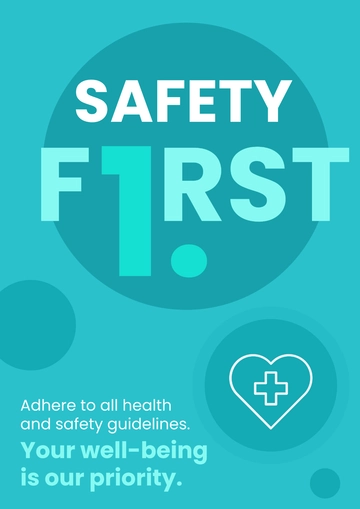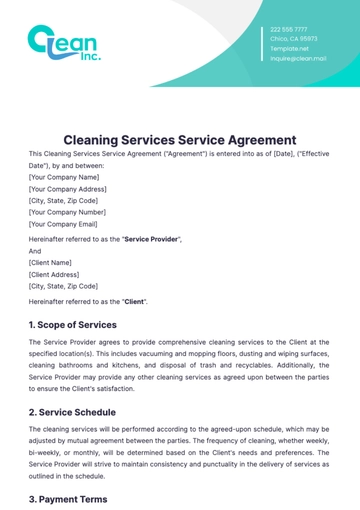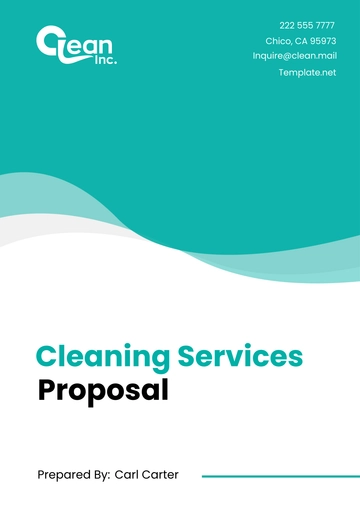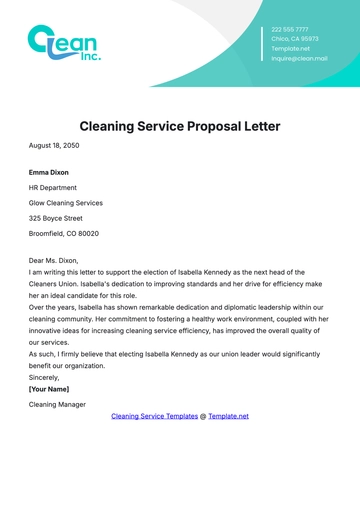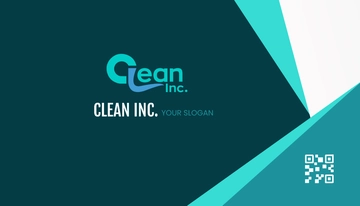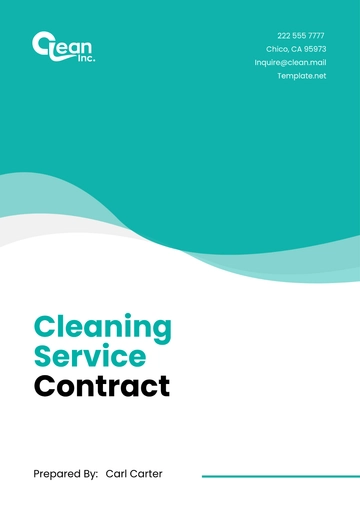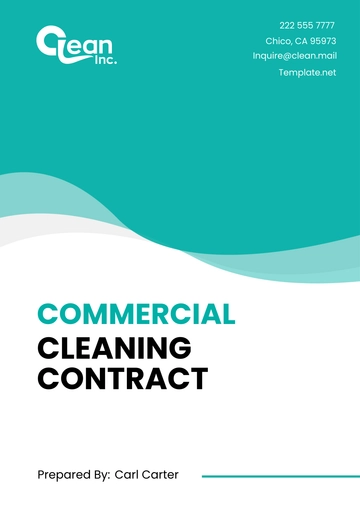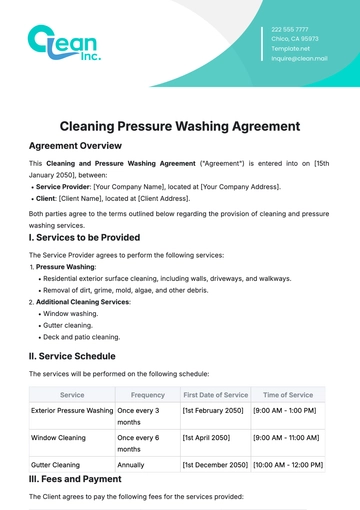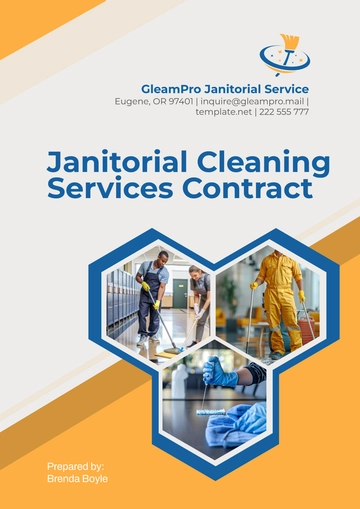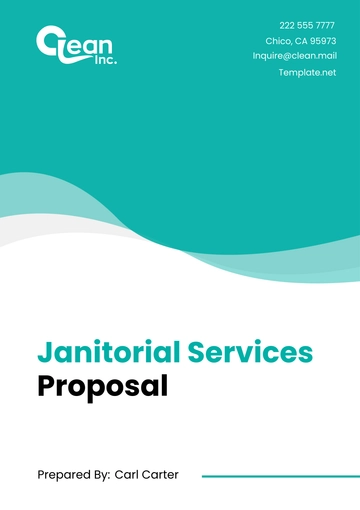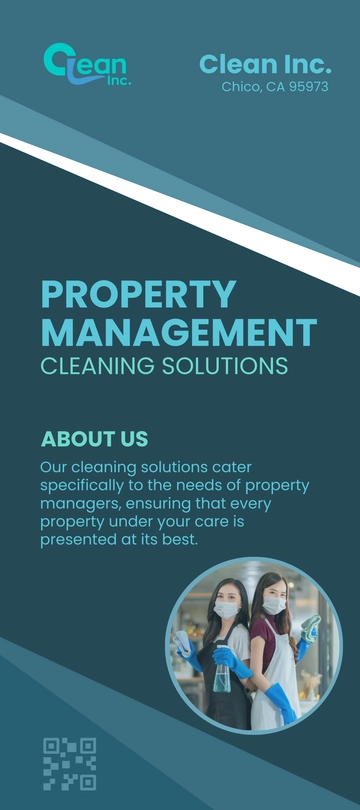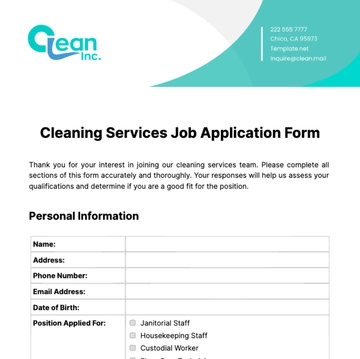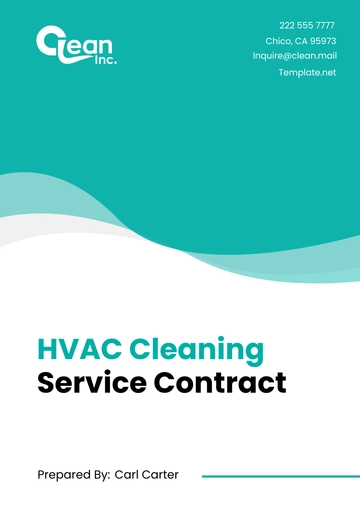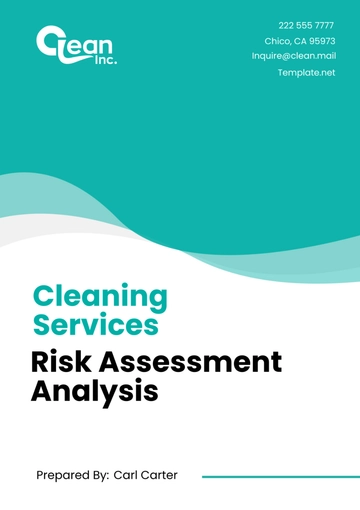Free Cleaning Services Compensation Review Process Document
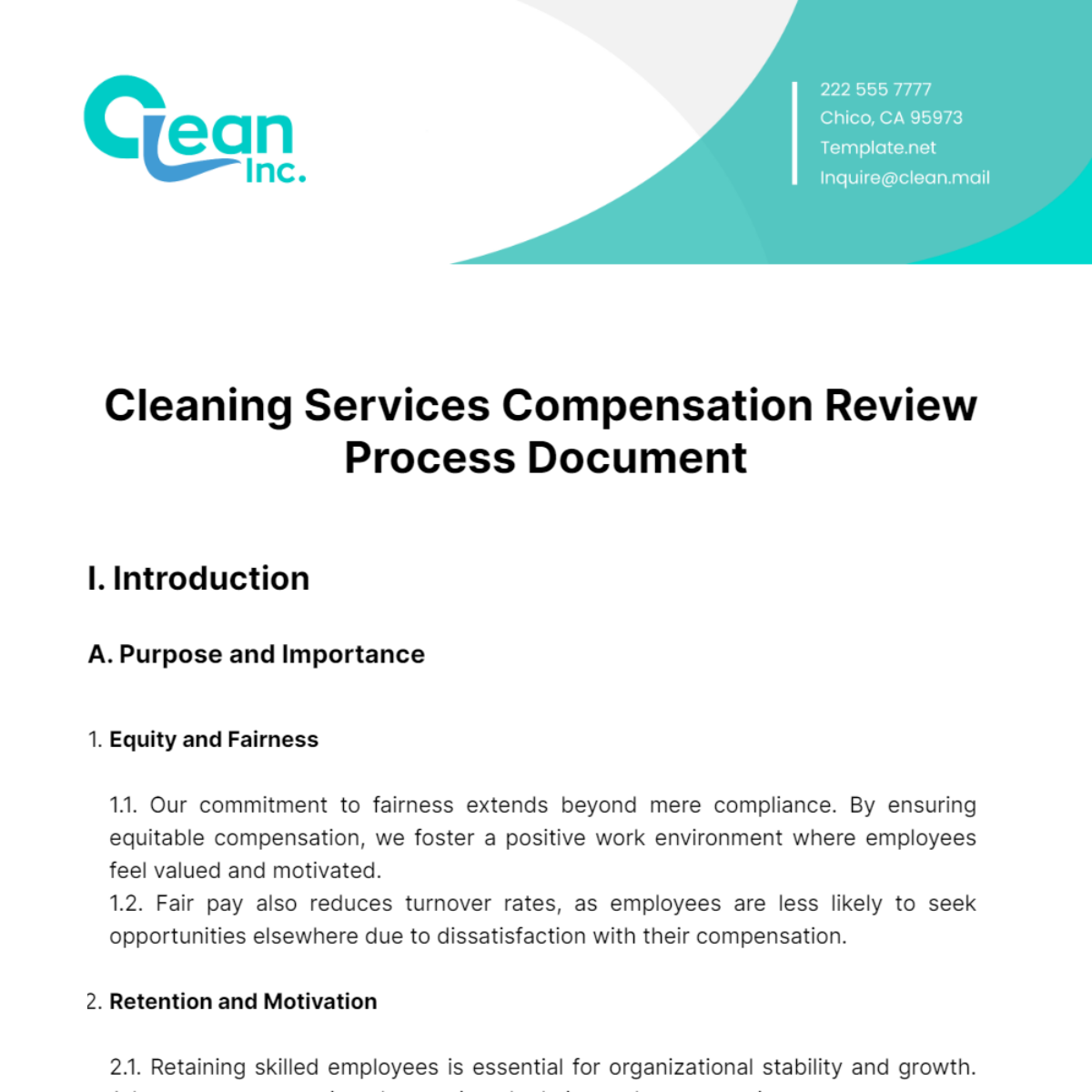
I. Introduction
A. Purpose and Importance
Equity and Fairness
1.1. Our commitment to fairness extends beyond mere compliance. By ensuring equitable compensation, we foster a positive work environment where employees feel valued and motivated.
1.2. Fair pay also reduces turnover rates, as employees are less likely to seek opportunities elsewhere due to dissatisfaction with their compensation.
Retention and Motivation
2.1. Retaining skilled employees is essential for organizational stability and growth. Adequate compensation plays a pivotal role in employee retention.
2.2. Motivated employees contribute to higher productivity, better customer service, and overall business success.
Market Competitiveness
3.1. Staying competitive in the industry requires benchmarking our compensation practices against market standards.
3.2. Regular reviews allow us to adjust salaries to match or exceed industry norms, attracting top talent and retaining experienced staff.
Financial Sustainability
4.1. While we prioritize employee well-being, we must also maintain fiscal responsibility.
4.2. Balancing competitive compensation with budget constraints ensures our long-term financial health.
B. Key Objectives
Transparency: Transparent communication about the compensation review process builds trust among employees. Clearly outlined steps, criteria, and timelines manage expectations.
Consistency: Consistency ensures that similar roles receive comparable compensation. Standardized criteria prevent bias and promote fairness.
Data-Driven Decisions: Rely on data to justify compensation adjustments. Metrics such as performance evaluations, market surveys, and financial projections guide our decisions.
Timeliness: Regular reviews prevent compensation from becoming outdated.
Timely adjustments align with changing market dynamics and organizational needs.
II. Process Initiation
A. Define the Review Goal
Objective Clarity: Clearly define the purpose of the compensation review. Is it to address salary disparities, enhance employee satisfaction, or align with strategic goals? A well-defined goal ensures focused efforts and meaningful outcomes.
Alignment with Organizational Goals: Link the review goal to broader organizational objectives. For instance, if our goal is to improve customer service, compensation adjustments may target frontline staff.
B. Data Collection
Employee Job Descriptions
1.1. Detailed job descriptions provide the foundation for fair compensation.
1.2. Consider responsibilities, required skills, and performance expectations.
1.3. Collaborate with department heads to validate and update descriptions.
Performance Metrics
2.1. Gather comprehensive performance data:
2.1.1. Quantitative metrics (e.g., sales targets met, productivity ratios).
2.1.2. Qualitative aspects (e.g., teamwork, leadership, customer feedback).
2.2. Evaluate both individual and team contributions.
Current Salaries
3.1. Compile accurate salary information, including base pay, bonuses, and incentives.
3.2. Maintain confidentiality while analyzing salary structures.
C. Review Team Formation
Stakeholder Inclusion: Assemble a diverse team:
Management: Strategic oversight.
HR: Compliance and fairness.
Finance: Budget implications.
Department Representatives: Contextual insights.
Roles and Responsibilities
2.1. Define each team member’s role clearly.
2.2. Establish communication channels and meeting schedules.
III. Data Analysis
A. Comprehensive Market Research
Understanding Competitor Practices
1.1. Conduct thorough market research to benchmark our compensation against industry standards.
1.2. Explore what competitors offer employees in similar job roles.
1.3. Consider factors such as base pay, bonuses, benefits, and incentives.
Salary Surveys and Reports
2.1. Utilize salary surveys and industry reports to gain insights.
2.2. Analyze data on compensation trends, regional variations, and sector-specific practices.
2.3. Identify any gaps or discrepancies between our current compensation structure and market norms.
B. Performance Evaluation
Holistic Assessment
1.1. Evaluate the overall performance of each employee.
1.2. Consider quantitative metrics (e.g., productivity, sales targets met) and qualitative aspects (e.g., teamwork, leadership).
1.3. Categorize employees based on their performance levels.
Performance-Compensation Alignment
2.1. Compare individual performance with existing salaries. Are high-performing employees appropriately rewarded? Are underperformers compensated fairly?
2.2. Adjustments should reflect performance contributions.
C. Revenue Forecasting
Financial Viability
1.1. Assess the company’s financial health and revenue projections. Can we sustain increased compensation without compromising profitability?
1.2. Consider short-term and long-term implications.
Budget Allocation: Allocate a portion of the budget specifically for compensation adjustments. Balance investment in human capital with other operational needs.
D. Stakeholder Consultation
Inclusive Approach
1.1. Engage all relevant stakeholders.
1.2. Gather diverse perspectives on compensation changes.
Feedback Collection
2.1. Conduct consultations, surveys, or focus groups.
2.2. Understand stakeholder concerns, preferences, and priorities.
2.3. Use this input to refine our compensation strategy.
IV. Compensation Structure Development
Upon completing the data analysis and stakeholder consultations, our focus shifts to designing a robust compensation structure. The following table outlines the critical elements that constitute our revamped approach to employee compensation:
Component | Description |
|---|---|
Base Salary | The fixed monetary amount paid to employees for their regular work hours. |
Variable Pay | Performance-based incentives, such as bonuses, commissions, or profit-sharing. |
Benefits Package | Additional perks beyond salary, including health insurance, retirement plans, and paid time off. |
Development Opportunities | Investments in employee growth, such as training programs, certifications, and career advancement paths. |
Our Base Salary serves as the bedrock of compensation. A competitive base salary ensures financial stability for employees, allowing them to focus on their work without undue stress. It also reflects our commitment to fair pay and attracts top talent. Benchmarking base salaries against industry standards ensures we remain competitive and reduces the risk of talent loss.
Variable Pay, such as bonuses or commissions, directly links effort to reward. Employees strive for excellence when they know their hard work will be recognized. Moreover, variable pay provides flexibility—during prosperous times, we can reward exceptional performance, and during lean periods, we can adjust variable components without affecting fixed costs.
The Benefits Package extends beyond salary to enhance overall quality of life. Health insurance, retirement plans, and paid time off contribute to physical and mental well-being. Comprehensive benefits differentiate us in the job market, attracting and retaining skilled employees.
Investing in Development Opportunities pays long-term dividends. Training programs, certifications, and career advancement paths not only enhance skills but also boost morale and increase retention. Clear career paths encourage loyalty and professional growth.
Our compensation structure isn’t static—it evolves alongside our company’s progress. It shapes our organizational culture, employee engagement, and business outcomes. A well-designed structure reinforces our commitment to fairness, transparency, and sustainable growth. Let’s continue refining it to empower our workforce and drive organizational excellence!
V. Implementation and Assessment
As we transition from planning to action, the successful implementation and ongoing assessment of our compensation structure are critical. These steps hold the key to our organizational effectiveness and employee satisfaction. Let’s delve into each aspect:
A. Communication
Effective Messaging
1.1. When communicating the newly devised compensation structure, we must go beyond mere announcements.
1.2. Clear, concise, and comprehensive messaging is essential. Employees need to understand not only the “what” but also the “why.”
1.3. Utilize multiple channels—company-wide emails, town hall meetings, and one-on-one discussions—to ensure everyone receives the information.
Transparency Matters
2.1. Transparency is our ally during this phase. Employees appreciate honesty.
2.2. Address potential concerns and questions promptly. Anticipate what employees might ask and provide thoughtful answers.
2.3. Highlight the benefits of the new structure: how it aligns with our strategic goals, promotes fairness, and supports individual growth.
B. Implement the Structure
Timely Execution
1.1. Implementation delays can erode confidence. Roll out the new compensation plan promptly.
1.2. Ensure that all relevant departments—HR, payroll, management—are aligned and ready for implementation. A synchronized effort minimizes disruptions and ensures a smooth transition.
Training and Guidance
2.1. Managers and HR personnel play a pivotal role in executing the structure. Train them thoroughly on the details. They need to understand not only the technical aspects but also the rationale behind the changes.
2.2. Provide guidance on how to communicate these changes to their teams. Clarity is key.
C. Re-evaluate and Modify
Periodic Reviews
1.1. Our compensation structure isn’t static; it’s a living system. Set specific review intervals—annually, biannually, or as needed.
1.2. During reviews, assess the effectiveness of the structure. Are employees satisfied? Is it achieving our intended outcomes?
Key Metrics Tell the Story
2.1. Measure what matters. Employee satisfaction surveys, retention rates, and performance metrics are our compass.
2.2. Solicit feedback from employees through surveys or focus groups. Their insights are invaluable.
2.3. Use data to drive decisions. If adjustments are necessary, make them promptly.
Flexibility and Adaptability
3.1. Market dynamics change, business goals evolve, and employee needs shift.
3.2. Our compensation structure should be flexible enough to adapt.
3.3. Be prepared to modify components as needed, always aligning with our strategic objectives.
VI. Conclusion
In the dynamic landscape of the cleaning services sector, regular compensation reviews transcend mere administrative tasks. They are strategic imperatives that impact both our employees and organizational growth.
Our commitment to systematic compensation reviews demonstrates our concern for employee well-being. Satisfied employees are more likely to stay, reducing turnover costs and maintaining organizational stability.
Moreover, a well-executed compensation review process ensures that we remain competitive. It allows us to adapt to market changes, industry trends, and evolving business needs.
Remember, our dedication to fairness, transparency, and sustainability drives every step of this process. As we move forward, let’s empower our workforce, foster excellence, and propel our cleaning service enterprise toward continued success!
- 100% Customizable, free editor
- Access 1 Million+ Templates, photo’s & graphics
- Download or share as a template
- Click and replace photos, graphics, text, backgrounds
- Resize, crop, AI write & more
- Access advanced editor
Compensation processes reviewed effectively with our adaptable Cleaning Services Compensation Review Process Document Template only on Template.net! This template is a fully editable and customizable document ensuring easier tailoring to your specific needs. The AI Editor Tool makes editing effortless, allowing you to create a comprehensive review process in minutes!
You may also like
- Cleaning
- Cleaning Brochure
- Cleaning Checklist Service
- Cleaning Estimate
- Cleaning Flyer
- Cleaning Invoice
- Cleaning Proposal
- Cleaning Quotation
- Cleaning Services Receipt
- Cleaning Services Roster
- Cleaning Schedule
- Cleaning Services Survey
- Cleaning Services Card
- Cleaning Services Banner
- Cleaning Services Form
- Cleaning Contract
- Cleaning Business Card
- Cleaning Services Agreement
- Cleaning Services Poster
- Cleaning Services Plan
- Cleaning Services Letterhead
- Window Cleaning
- Cleaning-Services Logo


